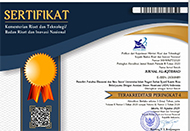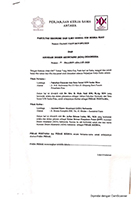ASSESSING THE INFLUENCE OF THE ISLAMIC FINANCIAL SYSTEM ON INDONESIA'S ECONOMIC GROWTH IN THE LONG AND SHORT RUN FROM 2011 TO 2022
Abstract
Keywords
Full Text:
PDFReferences
A, M., & Omar, A. (2012). Islamic Banking And Economic Growth: Indonesian Experience. International Journal of Islamic And Middle Eastern Finance and Management, Vol. 5(1), 2012 pp 35-47. DOI 10.1108/17538391211216811.
Abduh, M. (2012). Islamic banking and economic growth: the Indonesian Experience. International Journal of Islamic and Middle Eastern Finance and Management, 35-47.
Assidiq, R. (2023). Kritik atas Perdagangan Inovasi Kewirausahaan J.A.Schumpeter. Jurnal Pendidikan Ekonomi, Vol. 11(3).
Ayyubi, S., Anggraeni, L., & Mahiswari, A. D. (2017). Pengaruh bank syariah terhadap pertumbuhan ekonomi di Indonesia. Al-Muzara'ah, 5(2), 88-106.
Fatmawati, I. (2015). Analisis Pertumbuhan Ekonomi Indonesia Dengan Model Solow dan Schumpeter. Jurnal Fakultas Ekonomi Universitas Brawijaya, Vol. 3(3).
Fathoni, H. & Gina Sakinah. (2021). Peran Pasar Modal Syariah Dalam Laju Pertumbuhan Ekonomi Di Indonesia. Khazanah Multidisiplin, 2(1), 33-44.
Hossain, A. A. (2016). Inflammatory Shock And Real Output Growth in Nine Muslim Majority Countries: Implication For Islamic Banking And Finance. Journal of Asian Economics, No 45, pp.56-73. DOI 10.1016/j.asieco.2016.06.004.
Kamarni, N. (2015). Karakteristik Pembiayaan syariah Dan Kelembagaan Usaha Terhadap Pengembangan Usaha Mikro. Jurnal Ecosains, Vol. 4(2).
Kassim, S. (2016). Islamic Finance And Economic Growth: The Malaysian Experience. Global Finance Journal, No 30. Pp 66-76. DOI 10.1016/j.gfj.2015.11.007.
Lestari, N. (2021). Teori Pembangunan Ekonomi. Jurnal Manajemen Bisnis Islam, Vol. 2(2). DOI 10.24042/revenue.v2i2.9071.
Meuraxa, R. A. (2023). Analisis Dampak Kelayakan Pembiayaan bank Syariah Terhadap Usaha Mikro Kecil Dan Menengah. Edunomika, Vol. 7(1).
Michael, T. (2013). Pembangunan Ekonomi Edis Kesebelas. Jakarta: Erlangga.
Naz, S. A., & Gulzar, S. (2022). Impact of Islamic finance on economic growth: an empirical analysis of Muslim countries. The Singapore Economic Review, 67(01), 245-265.
Nurhidayah, D., Hidayati, A. N., & Habib, M. A. F. (2022). Pengaruh Inflasi, Saham Syariah, Sukuk dan Reksadana Syariah terhadap Pertumbuhan Ekonomi Nasional Tahun 2013-2020. Jurnal Sinar Manajemen, 9(1), 158-169.
Qamariyah, I. (2017). Pengaruh Tingkat Inflasi dan Pertumbuhan Ekonomi Terhadap Tingkat Pengangguran di Jawa Timur.
Rachmawati, M. (2015). faktor Yang Mempengaruhi Pergerakan Saham pada Indeks Saham Syariah Indonesia (ISSI) di Bursa Efek Indonesia (BEI).
Rahman, T. (2015). Deteminasi Pertumbuhan Ekonomi di ASEAN. Jurnal Media Komunikasi.
Salsabil, I. (2023). pengaruh Pertumbuhan Ekonomi, Tingkat Pendidikan, Kesehatan dan Pertumbuhan Ekonomi Terhadap Tingkat kemiskinan. jurnal Riset Ilmu Ekonomi Dan Bisnis, Vol. 3(1).
Santoso, H. (2015). Analisis Pembiayaan Ijarah Perbankan Syariah. Jurnal Ilmiah Ekonomi Islam.
Setiawan, I. (2021). Pembiayaan Umkm, Kinerja Bank Syariah Dan Pertumbuhan Ekonomi Di Indonesia. Islamic Banking: Jurnal Pemikiran Dan Pengembangan Perbankan Syariah, 6(2), 263-278.
Sukirno, S. (2015). Teori Pengantar Makroekonomi. Jakarta: PT. Raja Grafindo.
Suprijati, J. (2015). Pertumbuhan Ekonomi Di Kabupaten Bangkalan Setelah Adanya Pembangunan Jembatan Suramadu ( Anlisis Teori Harrod-Domar). Surabaya: Universitas Dr. Soetomo Surabaya.
Tabash, M. I., & Dhankar, R. S. (2014). The flow of Islamic finance and economic growth: An empirical evidence of Middle East. Journal of Finance and Accounting, 2(1), 11-19.
Taqwa, K. Z. (2017). Analisis Sistem Keuangan Syariah Terhadap Pertumbuhan Ekonomi Indonesia. Surabaya: Universitas Airlangga.
Ulpa, M. (2020). Konsep Pembiayaan Dalam Perbankan Syariah . Madani Syari'ah.
Widyastuti, E., & Arinta, Y. N. (2020). Perbankan Syariah dan Pertumbuhan Ekonomi Indonesia: Bagaimana Kontribusinya?. Al-Muzara'ah, 8(2), 129-140.
Wijayanti, D. (2002). Melacak Pembuktian Teori-teori Pertumbuhan Ekonomi. Jurnal Ekonomi Pembangunan, 181-186
DOI: http://dx.doi.org/10.24014/jiq.v19i2.27514
Refbacks
- There are currently no refbacks.















